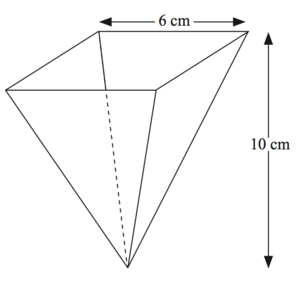Science:Math Exam Resources/Courses/MATH101/April 2008/Question 06
{{#incat:MER QGQ flag|{{#incat:MER QGH flag|{{#incat:MER QGS flag|}}}}}}
• Q1 (a) • Q1 (b) • Q1 (c) • Q1 (d) • Q1 (e) • Q1 (f) • Q1 (g) • Q2 (a) • Q2 (b) • Q2 (c) • Q2 (d) • Q3 (a) • Q3 (b) • Q3 (c) • Q3 (d) • Q4 (a) • Q4 (b) • Q5 (a) • Q5 (b) • Q6 • Q7 (a) • Q7 (b) •
|
Make sure you understand the problem fully: What is the question asking you to do? Are there specific conditions or constraints that you should take note of? How will you know if your answer is correct from your work only? Can you rephrase the question in your own words in a way that makes sense to you? |
|
If you are stuck, check the hints below. Read the first one and consider it for a while. Does it give you a new idea on how to approach the problem? If so, try it! If after a while you are still stuck, go for the next hint. |
Hint 1 |
|---|
|
First you will probably want to compute . To do this, use similar triangles. |
Hint 2 |
|---|
|
Next solve the differential equation. |
Hint 3 |
|---|
|
Now, you will have two unknowns, the k form the question and a constant you gained from integrating - call this C. Use the two initial conditions to solve for these two values. |
Hint 4 |
|---|
|
Now it is straightforward (so long as you haven't forgotten the goal!) Just solve for t when |
|
Checking a solution serves two purposes: helping you if, after having used all the hints, you still are stuck on the problem; or if you have solved the problem and would like to check your work.
|
Solution |
|---|
|
We will follow the strategy suggested in the hints above. Step 1. First, we compute A(y). If you look at the cup from the side, you can see a triangle with a base of 6 and a height of 10. The coffee level is a subtriangle (that is similar one) at height y and base length say b(y). Since these are similar triangles, we obtain that And so the area at height y is
becomes We rearrange the terms to obtain and we integrate with respect of t On the left side, it is a change of variable, so we can integrate with respect to y And now, computing each integral separately, we obtain the equation: for some constant c to determine. Rearranging the equation to write it as a function of y we obtain
The first one yields: And rearranging we can solve for c and find: This allows us to rewrite the function for y as: (We all would love to have that 10 come out with the powers that look like they would nicely simplify, but this is really not possible, so we continue.) Now, the second information y(10) = 5 will allow us to compute the value of k We do the algebra and get (Yes, it is a negative number, but it does make a lot of sense, since we expect dy/dt to be negative.) And so we have finally solved the differential equation and have now a "beautiful" expression for y(t) (after doing a little algebra to simplify it):
And by raising to the power 5/2 And obtain This last answer is as good as you can get without a calculator (you won't have one in the exam). Stopping anywhere earlier would work too, so if your simplification skills aren't great, it isn't a worry here, though it might make your life really hard earlier in the problem. And since you asked gently, the numerical value of that thing is around 12.147, which makes a bunch of sense given the way y decrease. |
{{#incat:MER CT flag||
}}






















